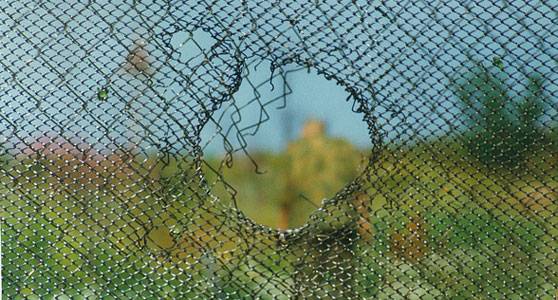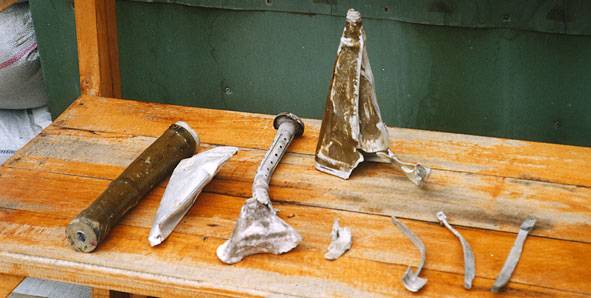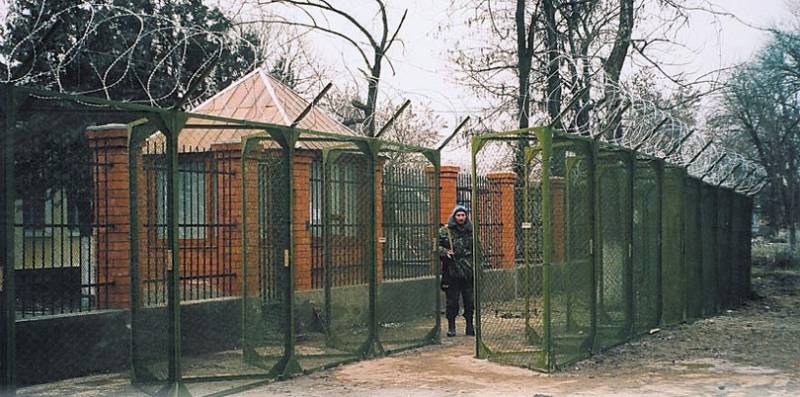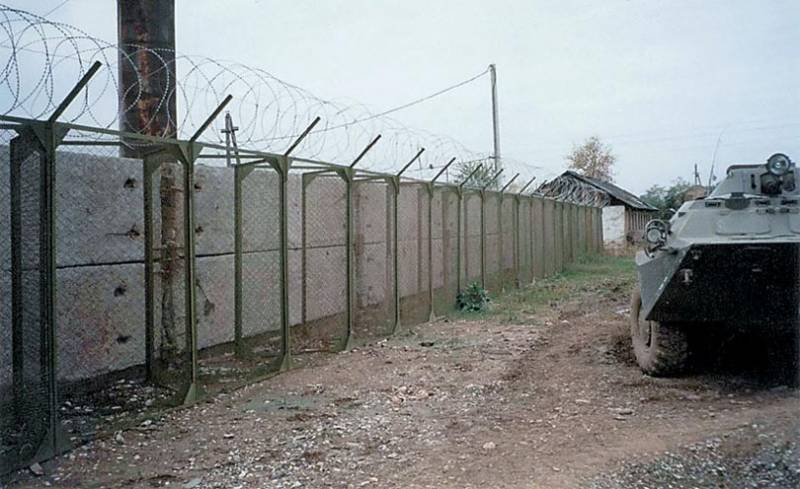Engineering protection system "Loza"
The experience of recent local conflicts shows that stationary objects of troops, such as roadblocks, barracks, warehouses, etc., can be subjected to fire using any weapons. Depending on their capabilities, the enemy can use small arms, light artillery or anti-tank systems. The latter, despite the other purpose, are fully capable of causing significant damage to buildings and buildings. Thus, buildings and structures may require special means of protection.
In the late nineties, the Scientific and Production Association of Special Materials (St. Petersburg) considered the current threats and needs of the troops, and also studied possible approaches to the protection of objects. Taking into account the results of such studies, the company has developed a new version of anti-cumulative protection of buildings, based on well-known principles. A promising development was named the Loza engineering protection system.
The Loza project was based on the well-known and proven principle of protecting an object using a mesh screen. Once in the path of a cumulative munition, such an obstacle provokes its disruption or disrupts the integrity of the charge - in both cases, the impact on the protected object is sharply reduced. At the same time, the specialists of the Scientific Production Association SM took into account some features of the work of cumulative combat units and formed an updated screen that could show higher characteristics.
The main element of the Loza protection system is a rectangular screen-module. It is a frame of metal profiles, reinforced at the corners with triangular kerchiefs. Each module has a width of 2 m and a height of 2,5 m, which allows you to cover the screens of any standard fence or fence. The frames are equipped with special devices for quick installation and connection of several modules into a large structure of the required configuration.
On the frame, a metal grid with an interlacing of the type of chain-link net is stretched. The size and shape of the cells of such a grid is determined in accordance with the parameters of the most common cumulative ammunition used with popular anti-tank grenade launchers. The relatively small size of rhombic cells guarantee the contact of a flying grenade at once with several sections of the wire. The sufficient strength of the wire and the network woven from it, in turn, makes it possible to destroy the head of the munition or provoke its premature operation.
Since a single network cannot always provide the required protection against any conventional ammunition, the designers of special materials made the Loza system two-layer. In its composition there are two rows of mesh barriers located in a special way. The external row of screen modules forms a straight line or contour of the required shape, whereas the inner one along its entire length is a broken line.
Installation of engineering protection system "Loza" is not the most difficult task. Along the perimeter of the protected object, it is proposed to dig in or drive in supporting columns of a given height. The distance between the individual pillars is equal to 2 meters - the width of the frame-module. Separate screens are installed between the columns in one line, forming the first perimeter of protection. In the event of an attack, it is he who will have to absorb the kinetic energy of the munition and take over part of the shock wave and the cumulative jet when it is blown up.
On the same support pillars with the help of the proposed fasteners installed the second row of protection. For each screen of the first row at a large angle to it, it is proposed to mount two other modules. Three modules form a triangular construction with two lines of protection. Two vertices of such a triangle are located at the pillars, and the third is located on the side of the protected object. The combined use of two rows of screens with their installation at an angle to each other, it is claimed, greatly enhances the combat characteristics of the entire complex.
According to the manufacturer, the Loza protection system can be completed with additional means of preventing access. Brackets with fasteners inclined 45 ° outwards can be mounted on the support posts of the system. They should be hung with barbed wire, which will not allow the offender to move through the screens.
The best results system "Loza" shows when installing in compliance with all recommendations of the developer. It is recommended to install it at a distance of the order of 10-20 m from the protected object, which allows to exclude all the main risks during shelling. According to official data, in optimal configuration, the screens remove the high-impact impact on the building, and also reduce to a safe level the risks associated with fragments and a cumulative jet.
It is argued that the engineering protection system can be used to improve the security of various objects of small height. At the same time, it serves as a special addition to other standard protective equipment and structures. For example, there is a brick or concrete fence around a warehouse, headquarters, or other object that, by definition, cannot withstand shelling from anti-tank weapons. At a given distance from such a fence, the "Vine" can be deployed, as a result of which the object will receive comprehensive protection from violators and various weapons.
A characteristic feature of the screens "Vine" is their purpose. This protection system is intended only for equipping stationary objects. Modification for installation on armored vehicles was not developed. In this regard, the domestic screen differs from some foreign developments, the authors of which tried to create universal protection for mounting on stationary and moving objects.

Screen after hitting an RPG-7 grenade
From the point of view of the basic principles of work, “Loza” does not differ from other similar systems. Moreover, its design uses such principles in a rather interesting way. The flying grenade must hit the outer screen, which has known consequences. The grenade is either mechanically destroyed, or undermined at an excessive distance from the attacked target.
In the latter case, an explosion and a cumulative jet pierce the network of the first screen. However, further on their way at some distance from the first screen is the second. Much of the remaining energy of the jet is spent on making a hole in the new barrier, after which the remnants of the jet are scattered in the air. Even if part of the hot gases or molten metal reaches the protected object, they will not be able to damage it. At the same time, a pair of grids will hold up a significant portion of the fragments.
In the best case, hitting the net results in the destruction of a grenade. The promotional materials from NGOs special materials showed the result of this development. Having hit the first screen, the PG-7 grenade of the RPG-7 rocket launcher was divided into many separate parts, which, moreover, were seriously deformed. Instead of a single grenade shot, a curved fairing and a grenade body, a battered engine shank, as well as torn and twisted stabilizers were shown. The broken screen grid, however, didn’t look any better after hitting a grenade.
According to the NGO SM, the mesh screens of the Loza system are distinguished by their unique resistance to explosions of cumulative ammunition. If a grenade PG-7B is damaged, the grid is destroyed on an area of no more than 5 sq. Dm - the screen gap has a diameter within 20-25 cm. Thus, one hit of a grenade disables about 1% of the entire area of the screen module. The other area of the product probably retains the required characteristics and can continue to perform its tasks.
It is worth noting that the screens made of metal mesh, especially supplemented with brackets with barbed wire, can be protected not only from anti-tank weapons. They are also able, at a minimum, to detain the intruder and prevent him from quickly entering the restricted area. The presence of the “spike” makes it very difficult to overcome the barrier through the top, and it takes a lot of time to cut the mesh. In addition, the second row of screens becomes an additional obstacle. It can be said that the "Vine" in combination with any other fence creates a real multi-purpose defense in depth.
According to the information available, the Loza engineering protection system, developed and introduced at the end of the nineties, quickly found its customers and went into production. Various military and civilian structures appreciated the original proposal of domestic engineers, as a result of which special materials NGOs could master the production of a new type of product.

Debris from a reactive grenade after meeting with "Vine"
According to various sources, Loza screens have been deployed on a variety of sites throughout the country. Special attention is drawn to the well-known facts of the use of engineering protection systems in the territory of the Chechen Republic. In the recent past, military units and civilian objects of this subject of the federation, for obvious reasons, were subjected to special risks. The available means of protection could not always cope with current threats, and therefore systems like Vines were not redundant.
Objects from other regions for which Chechnya’s problems were not characteristic could have used an engineering protection system as an addition to existing defenses. In this case, it could be used, first of all, as a second fence around the object. The anti-cumulative function turned out to be not the most necessary, but not a superfluous addition.
It is curious that operators did not always succeed in complying with all the recommendations of the manufacturer and deploying the engineering protection system in the optimal configuration. According to the calculations of NPO SM, the Vine shows the best results when installing screens at a distance of at least 10 m from the protected object. In this case, the not completely destroyed cumulative jet or fragments have time to lose all their energy and cease to threaten their goal. Reducing the distance to the screen may increase risks.
However, it was not always possible to install screens at a sufficient distance. As a result, the construction of mesh modules was mounted, including, in the immediate vicinity of its own fence of the object. It is unknown how much the effectiveness of the barrier decreased. However, it can be assumed that with a pair of mesh screens the concrete fence protected people and the material part better than without them.
Engineering protection systems "Loza" are manufactured and operated so far. Apparently, since the beginning of the two thousand years, anti-cumulative screens of modular design, supplied by NGOs of special materials, have been regularly deployed in new and new facilities in different parts of the country. Information on the number of systems released is not available, but it can be assumed that the account of serial sets has long gone by hundreds. "Loza" remains in the product catalog of the company-developer, and to this day is offered to potential customers.
Mesh screens of several models have already entered the service of a number of armies, and, as some events show, they cope with their task by sharply reducing the negative impact of ammunition on the protected equipment. In some cases we are talking about the installation of unified nets and combat vehicles, and stationary objects. The domestic project of the engineering protection system “Loza” also provides protection for various buildings, but does not provide for installation of screens on the machines. However, the “narrow specialization” of this system allows you to get rid of possible problems associated with universality, and to obtain the desired potential in the matter of protection. Numerous orders for the supply of modules for installation at various sites have long been a clear confirmation of the high performance of Loza.
On the materials of the sites:
https://npo-sm.ru/
https://dfnc.ru/
http://psj.ru/
http://armor.kiev.ua/


Information